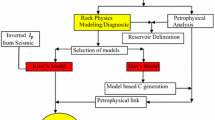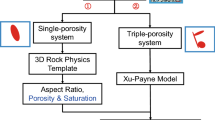Abstract
Carbonate reservoirs have complex pore structures, which not only significantly affect the elastic properties and seismic responses of the reservoirs but also affect the accuracy of the prediction of the physical parameters. The existing rock-physics inversion methods are mainly designed for clastic rocks, and the inversion objects are generally porosity and water saturation The data used are primarily based on the elastic parameters, and the inversion methods are mainly linear approximations To date, there has been a lack of a simultaneous pore structure and physical parameter inversion method for carbonate reservoirs. To solve these problems, a new Bayesian nonlinear simultaneous inversion method based on elastic impedance is proposed. This method integrates the differential effective medium model of multiple-porosity rocks, Gassmann equation, Amplitude Versus Offset (AVO) theory, Bayesian theory, and a nonlinear inversion algorithm to achieve the simultaneous quantitative prediction of the pore structure and physical parameters of complex porous reservoirs. The forward modeling indicates that the contribution of the pore structure, i.e., the pore aspect ratio, to the AVO response and elastic impedance is second only to that of porosity and is far greater than that of water saturation. The application to real data shows that the new inversion method for determining the pore structure and physical parameters directly from pre-stack data can accurately predict a reservoir’s porosity and water saturation and can evaluate the pore structure of the effective reservoir.
Similar content being viewed by others
References
Aki K, Richards P G. 1980. Quantitative Seismology. San Francisco: W. H. Freeman & Co
Anselmetti F S, Eberli G P. 1993. Controls on sonic velocity in carbonates. Pure Appl Geophys, 141: 287–323
Avseth P, Mukerji T, Mavko G. 2005. Quantitative Seismic Interpretation: Applying Rock Physics Tools to Reduce Interpretation Risk. Cambridge: Cambridge University Press
Ba J, Xu W H, Fu L Y, Carcione J M, Zhang L. 2017. Rock anelasticity due to patchy saturation and fabric heterogeneity: A double double-porosity model of wave propagation. J Geophys Res-Solid Earth, 122: 1949–1976
Bachrach R. 2006. Joint estimation of porosity and saturation using stochastic rock-physics modeling. Geophysics, 71: O53–O63
Baechle G T, Colpaert A, Eberli G P, Weger R J. 2008. Effects of microporosity on sonic velocity in carbonate rocks. Leading Edge, 27: 1012–1018
Biot M A. 1956a. Theory of propagation of elastic waves in a fluid-saturated porous solid. I. Low-frequency range. J Acoust Soc Am, 28: 168–178
Biot M A. 1956b. Theory of propagation of elastic waves in a fluid-saturated porous solid. II. Higher frequency range. J Acoust Soc Am, 28: 179–191
Bosch M, Carvajal C, Rodrigues J, Torres A, Aldana M, Sierra J. 2009. Petrophysical seismic inversion conditioned to well-log data: Methods and application to a gas reservoir. Geophysics, 74: O1–O15
Brie A, Pampuri F, Marsala A, Meazza O. 1995. Shear sonic interpretation in gas-bearing sands. SPE Annual Technical Conference and Exhibitionn. Society of Petroleum Engineers. 701–710
Connolly P. 1999. Elastic impedance. Leading Edge, 18: 438–452
Dou Q, Sun Y, Sullivan C. 2011. Rock-physics-based carbonate pore type characterization and reservoir permeability heterogeneity evaluation, Upper San Andres reservoir, Permian Basin, west Texas. J Appl Geophys, 74: 8–18
Dvorkin J, Nur A. 1993. Dynamic poroelasticity: A unified model with the squirt and the Biot mechanisms. Geophysics, 58: 524–533
Fang Z L, Yang D H. 2015. Inversion of reservoir porosity, saturation, and permeability based on a robust hybrid genetic algorithm. Geophysics, 80: R265–R280
Gassmann F. 1951. Über die elastizität poröser medien. Vier der Natur Gesellschaft Zürich, 96: 1–23
González E F, Mukerji T, Mavko G. 2008. Seismic inversion combining rock physics and multiple-point geostatistics. Geophysics, 73: R11–R21
Grana D. 2016. Bayesian linearized rock-physics inversion. Geophysics, 81: D625–D641
Grana D, Rossa E D. 2010. Probabilistic petrophysical-properties estimation integrating statistical rock physics with seismic inversion. Geophysics, 75: O21–O37
Ingber L. 1989. Very fast simulated re-annealing. Mathematical & Computer Modelling, 12: 967–973
Jin M, Zeng W, Tan X, Li L, Li Z, Luo B, Zhang J, Liu J. 2014. Characteristics and controlling factors of beach-controlled karst reservoirs in Cambrian Longwangmiao Formation, Moxi-Gaoshiti area, Sichuan Basin, NW China. Pet Exploration Dev, 41: 712–723
Kuster G T, Toksöz M N. 1974. Velocity and attenuation of seismic waves in two media, Part I. Theoretical considerations. Geophysics, 39: 587–606
Lang X, Grana D. 2018. Bayesian linearized petrophysical AVO inversion. Geophysics, 83: M1–M13
Li H B, Zhang J J. 2010. Modulus ratio of dry rock based on differential effective-medium theory. Geophysics, 75: N43–N50
Li H B, Zhang J J. 2011. Elastic moduli of dry rocks containing spheroidal pores based on differential effective medium theory. J Appl Geophys, 75: 671–678
Li H B, Zhang J J, Yao F C. 2013. Inversion of effective pore aspect ratios for porous rocks and its applications (in Chinese). Chin J Geophys, 56: 608–615
Li H B, Zhang J J. 2014. A differential effective medium model of multiple-porosity rock and its analytical approximations for dry rock (in Chinese). Chin J Geophys, 57: 3422–3430
Li H B, Zhang J J, Cai S J, Pan H J. 2019. Analysis of 3D rock physics template for reservoir with complex pore structure (in Chinese). Chin J Geophys, 62: 2711–2723
Li H B, Zhang J J, Cai S J, Pan H J. 2020. A two-step method to apply Xu-Payne multi-porosity model to estimate pore type from seismic data for carbonate reservoirs. Pet Sci, 17: 615–627
Li K, Yin X, Zong Z. 2020. Facies-constrained prestack seismic probabilistic inversion driven by rock physics. Sci China Earth Sci, 63: 822–840
Liu H, Hou X. 2008. Research on the key parameters in the simulated Annealing algorithm. Computer Eng Sci, 30: 55–57
Luo T, Feng X, Guo Z, Liu C, Liu X. 2019. Seismic Inversion of anisotropy parameters of fracture reservoirs by simulated annealing and particle swarm optimization. J Jilin Univ-Earth Sci Ed, 49: 1466–1476
Mavko G, Mukerji T, Dvorkin J. 2009. The Rock Physics Handbook. Cambridge: Cambridge University Press
Mori T, Tanaka K. 1973. Average stress in matrix and average elastic energy of materials with misfitting inclusions. Acta Metall, 21: 571–574
Mukerji T, Jørstad A, Avseth P, Mavko G, Granli J R. 2001. Mapping lithofacies and pore-fluid probabilities in a North Sea reservoir: Seismic inversions and statistical rock physics. Geophysics, 66: 988–1001
Nie J X, Yang D H, Yang H Z. 2004. Inversion of reservoir parameters based on the BISQ model in partially saturated porous media (in Chinese). Chin J Geophys, 47: 1101–1105
Norris A N. 1985. A differential scheme for the effective moduli of composites. Mech Mater, 4: 1–16
Pride S R, Berryman J G. 2003. Linear dynamics of double-porosity dual-permeability materials. I. Governing equations and acoustic attenuation. Phys Rev E, 68: 036603
Russell B. 1988. Introduction to seismic inversion methods. SEG Course Notes Series
Sayers C M. 2008. The elastic properties of carbonates. Leading Edge, 27: 1020–1024
Spikes K, Mukerji T, Dvorkin J, Mavko G. 2007. Probabilistic seismic inversion based on rock-physics models. Geophysics, 72: R87–R97
Sun Y F. 2004. Pore structure effects on elastic wave propagation in rocks: AVO modelling. J Geophys Eng, 1: 268–276
Whitcombe D N. 2002. Elastic impedance normalization. Geophysics, 67: 60–62
Xu S, Payne M A. 2009. Modeling elastic properties in carbonate rocks. Leading Edge, 28: 66–74
Yang D, Zhang Z. 2002. Poroelastic wave equation including the Biot/Squirt mechanism and the solid/fluid coupling anisotropy. Wave Motion, 35: 223–245
Yin X Y, Cui W, Zong Z Y, Liu X J. 2014. Petrophysiccal property inversion of reservoirs based on elastic impedance (in Chinese). Chin J Geophys, 57: 4132–4140
Yin X Y, Zong Z Y, Wu G C. 2015. Research on seismic fluid identification driven by rock physics. Sci China Earth Sci, 58: 159–171
Yuan S, Liu Y, Zhang Z, Luo C, Wang S. 2019. Prestack stochastic frequency-dependent velocity inversion with rock-physics constraints and statistical associated hydrocarbon attributes. IEEE Geosci Remote Sens Lett, 16: 140–144
Zhang B, Yang D, Cheng Y, Zhang Y. 2019. A unified poroviscoelastic model with mesoscopic and microscopic heterogeneities. Sci Bull, 64: 1246–1254
Zhang G, Zhao C, Tu Q, Liu J, Zhang J. 2018. Prestack stochastic inversion based on the quantum annealing Metropolis-Hastings algorithm (in Chinese). Oil Geophys Prospect, 53: 153–160
Zhang J J, Yin X Y, Zhang G Z, Gu Y P, Fan X G. 2020. Prediction method of physical parameters based on linearized rock physics inversion. Petrol Explor Develop, 47: 57–64
Zhang T T, Zhang R F, Tian J Z, Lu L F, Qin F Q, Zhao X Z, Sun Y F. 2018. Two-parameter prestack seismic inversion of porosity and pore-structure parameter of fractured carbonate reservoirs: Part 2—Applications. Interpretation, 6: 1–36
Zhao L, Nasser M, Han D. 2013. Quantitative geophysical pore-type characterization and its geological implication in carbonate reservoirs. Geophys Prospect, 61: 827–841
Acknowledgements
We thank the editorial board members and anonymous reviewers for their valuable comments on this paper. This work was supported by the National Key Research and Development Program of China (Grant No. 2019YFC0605504) and the Scientific Research & Technology Development Project of China National Petroleum Corporation (Grant No. 2017D-3504).
Author information
Authors and Affiliations
Corresponding authors
Rights and permissions
About this article
Cite this article
Li, H., Zhang, J., Pan, H. et al. Nonlinear simultaneous inversion of pore structure and physical parameters based on elastic impedance. Sci. China Earth Sci. 64, 977–991 (2021). https://doi.org/10.1007/s11430-020-9773-8
Received:
Revised:
Accepted:
Published:
Issue Date:
DOI: https://doi.org/10.1007/s11430-020-9773-8




